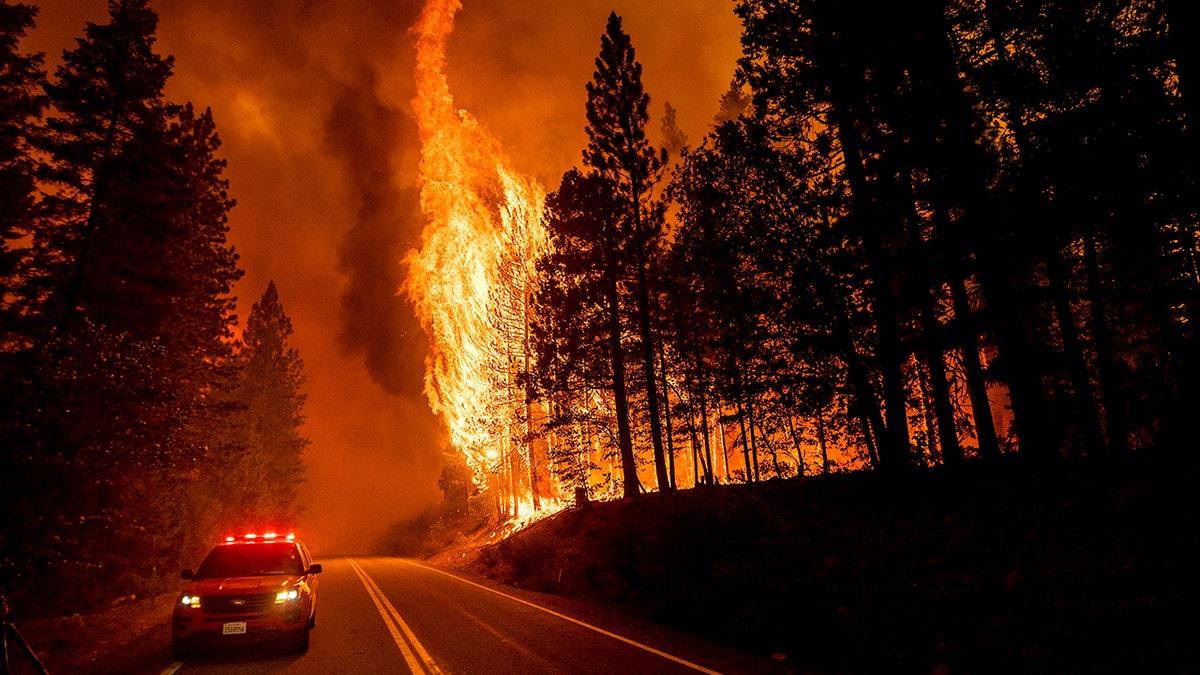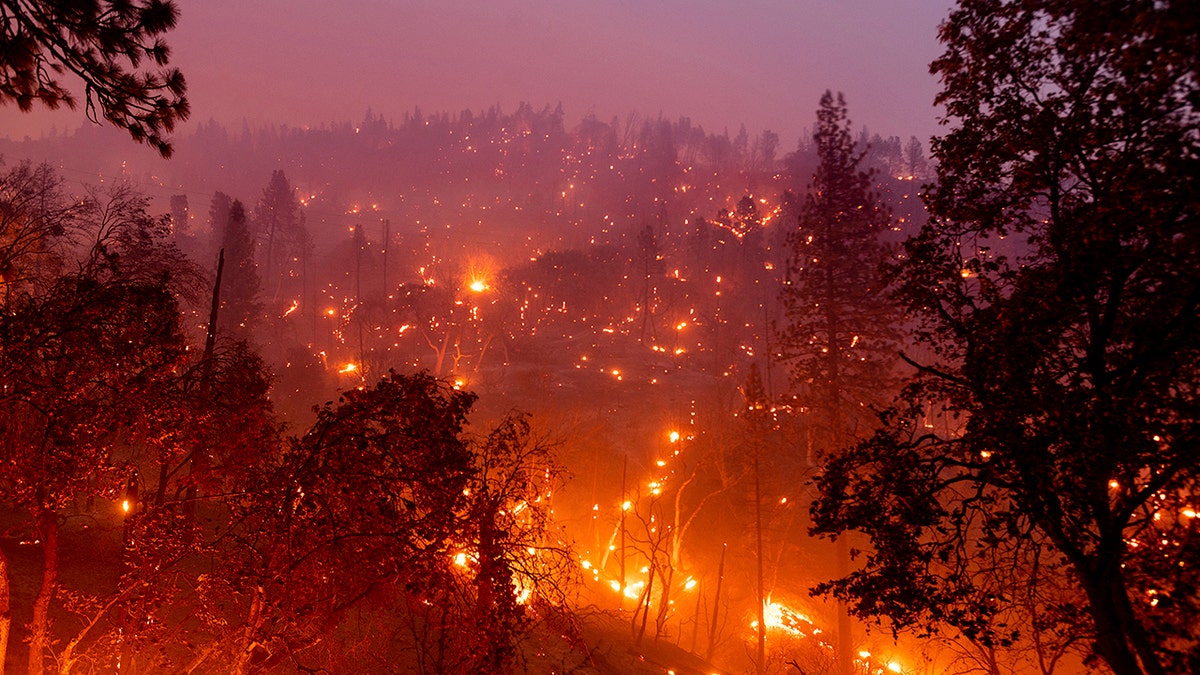California treasure hunters find gold nuggets in soil amid wildfires
Albert Fausel sells mining equipment at his family's hardware store and he joined 'Fox & Friends' to discuss how he discovered gold amid the wildfires.
As Californians look forward to the summer to enjoy the sunny weather and blue waters, they are now accustomed to something else lurking in the background: the threat of wildfires.
Out-of-control wildfires don’t just ravage forests and destroy homes — they also may impact the care of patients in hospital facilities as well as other on-site health-care focused facilities.
A group of researchers found that roughly half of California’s total inpatient capacity is within one mile from a high fire threat zone (FTZ), according to a new study published in American Journal of Public Health, a monthly peer-reviewed public health journal.
LARGEST CALIFORNIA WILDFIRE SEEN FROM NOAA SPACE SATELLITE
The state of California "is experiencing an intensifying wildfire crisis," said the study's authors. The group included Neil Singh Bedi, Caleb Dresser, Akash Yadav and others.
Bedi is with the Boston University School of Medicine in Boston. Dresser is with Beth Israel Deaconess Medical Center/Harvard Medical School in Boston and Yadav is with the Department of Epidemiology at the Harvard University T. H. Chan School of Public Health, also in Boston.

Flames leap from trees as the Dixie Fire jumps Highway 89 north of Greenville in Plumas County, California, on Aug. 3, 2021. (AP Photo/Noah Berger, File)
"Of the 20 largest wildfires in the state’s history, all but three took place in the past two decades, with seven [wildfires] occurring in 2020 and 2021," the wrote.
They raised significant concern especially about Northern California, where two of the state’s largest fires burned over a million acres over the past several years.
FIREFIGHTERS PARTIALLY CONTAIN DEADLIEST AND MOST DESTRUCTIVE FIRE OF THE YEAR
Human-caused climate change has doubled the cumulative forest fire area from 1984 to 2015 — a trend experts expect to continue due to warmer weather and drier landscapes, according to previous research.
The study authors reviewed data updated as of October 2022 for licensed inpatient facilities that treat patients for longer than 24 hours.
"This study shows the importance of planning for the future in the face of climate change," Dr. David Dowdy, an epidemiologist and professor at the Johns Hopkins Bloomberg School of Public Health in Baltimore, Maryland, told Fox News Digital. He was not part of the study.
The wildfires not only threaten the physical structure of the health care buildings — but may also disrupt operations and the access of individuals to care, the researchers found.
Wildfires were responsible for 18.4% of hospital evacuations in the United States since 2001 — with some California hospitals in Sonoma County requiring more than one evacuation in the same fire season, according to the study.
Fire threat zones
The authors used publicly available data from the California Department of Health and Human Services (CAL FIRE) to analyze how close the state’s inpatient health care facilities were to fire threat zones (FTZ).

Firefighters work on California's McKinney Fire, which burned in the Klamath National Forest in western Siskiyou County, California, during the 2022 California wildfire season. (U.S. Forest Service - Klamath National Forest)
The study authors reviewed data updated as of October 2022 for licensed inpatient facilities that treat patients for longer than 24 hours.
CAL FIRE risk stratifies the state into six FTZ categories — not mapped, low, moderate, high, very high and extreme — depending on how likely a fire is expected to occur in that area and the potential behavior of that fire.
Half the total inpatient bed capacity in California is within 3.3 miles of a very high fire threat zone.
After including a total capacity of 214, 358 inpatient beds across 3087 facilities in their analyses, the researchers found that 50% of total inpatient capacity (107, 290 beds) were within 0.87 miles of a high FTZ and 95% of capacity (203, 665 beds) within 3.7 miles of a high FTZ.
They also noted that half the total inpatient bed capacity is within 3.3 miles of a very high FTZ and 15.5 miles of an extreme FTZ.
"We found that a high percentage of inpatient health care facilities in California are at risk for potential operational disruption or evacuation from wildfires," the authors concluded.

The new research is based on current risk exposure according to CAL FIRE data. The study's authors did not perform climate change scenarios to assess future fire risk. (Martin Barraud via Getty Images)
"In many counties, all health care facilities may be at risk," they added.
The study's limitations
The research is based on current risk exposure according to CAL FIRE data; but the study's authors did not perform climate change scenarios to assess future fire risk, which is likely to exceed current risk levels in many locations.
They also note that they did not evaluate the structural characteristics of the health care facilities and the degree of fire protection in the environment surrounding the facilities, such as the amount of vegetation in the area.
Patients in general hospitals are of "particular concern."
The researchers caution that health care facilities that are not close to a FTZ still may be affected by wildfires if those facilities lack significant "fire suppression capabilities" and other features like back-up generators, which the authors also did not assess.
Implications of the study
Patients in general hospitals are of "particular concern," the study indicated.

In this file photo from Aug. 25, 2021, the French Fire burns hillsides along Highway 155 in Sequoia National Forest, California. (Noah Berger/AP)
That's because of the difficulties associated with evacuating hospitalized patients, the limited numbers of other facilities that can assume their care and the loss of emergency care services when they’re temporarily closed due to wildfires.
NEVADA CHILDREN HAVE EXPERIENCED RARE BRAIN INFECTION AND ABSCESSES AS CDC INVESTIGATES
Patients in long-term care facilities, such as nursing homes, are also at high risk during evacuation, as previous research shows an increase in mortality after forced evacuations.
"As we plan for our response to wildfires, hospitals need to be high on the list of priorities."
Special populations with behavioral health needs, such as involuntarily hospitalized patients, require additional security safeguards, complicating the evacuation process.
"Evacuating an entire hospital would be a very dangerous operation — for example, you may have people on ventilators whose lives would be put at risk if they had to move to a different facility," Dowdy told Fox News Digital.
CLICK HERE TO SIGN UP FOR OUR HEALTH NEWSLETTER
"As we plan for our response to wildfires, hospitals need to be high on the list of priorities," he added.
CLICK HERE TO GET THE FOX NEWS APP
"And as the risk of wildfires increases over time, we need to consider how we protect people who are medically very vulnerable," Dowdy also said.

